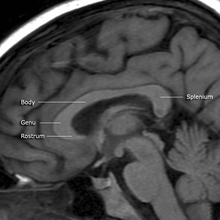Corpus callosum

The corpus callosum ( Latin corpus "body", callus "callus"), also called commissura magna or bar , (rarely brain bar or brain bar ) is a large system of commissures in the brain of placenta , a subclass of mammals , across between the two Hemispheres of the cerebrum and connects them. The corpus callosum belongs to the white matter of the endbrain and consists of around 250 million nerve fibers in humans .
Structure and functions
The corpus callosum consists of the parts rostrum (beak), genu (knee), trunk (trunk) and splenium (rear end). It runs at the bottom of the large longitudinal fissure in the brain and forms the roof of the two lateral ventricles .
The bar is used for the exchange of information and the coordination between the two hemispheres, which each have different tasks in information processing.
The partially double-ended fibers of the beam connect mainly identical cortical areas of the respective hemispheres with one another, but also occasionally different areas. Since it is shorter than the hemispheres, only its middle fibers are placed across. The anterior fibers, which radiate through the barbed knee to the frontal poles , and the posterior fibers, which extend through the splenium to the occipital poles, are bent into a U-shape. Because of this forceps shape, the frontal U-fibers are summarized as Forceps frontalis ( minor ), the occipital ones as Forceps occipitalis ( major ).
The dorsal surface of the bar is covered by a thin gray coating ( Indusium griseum ), which can be assigned to the cortical limbic areas .
Medical aspects
For some forms of epilepsy , treatment may include: a. involves surgically cutting the bar (but generally leaving at least the splenium intact). This is to prevent the excitation from being transmitted to the other half of the brain. Especially in the case of fall epilepsy, the frequency and severity of the falls, which are often associated with serious injuries, can usually be significantly reduced. On the other hand, this so-called split-brain operation or callosotomy is associated with severe cognitive disorders , so that it is rarely performed these days. In addition, the split-brain syndrome, named after it, occurs because of the severing of the bar. In his book The Man Who Mistook His Wife for a Hat , Oliver Sacks reports on such a patient and mentions that in this particular case both halves of the brain work separately from one another. For example, he uses experiments to show that the language center in the left hemisphere can no longer communicate with the visual center in the right hemisphere.
The bar stitch is an older treatment method for increased intracranial pressure.
The congenital absence of the bar is called corpus callosum agenesis .
The Mild Encephalopathy with Reversible Lesion in the splenium (MERS) is a on the rear end ( splenium limited) of the bar encephalopathy , which usually occurs with infections.
Web links
Individual evidence
- ↑ Benninghoff: Macroscopic and microscopic anatomy of humans. Volume 3 Nervous System, Skin and Sense Organs . Urban and Schwarzenberg, Munich 1985, ISBN 3-541-00264-6 , p. 158.


